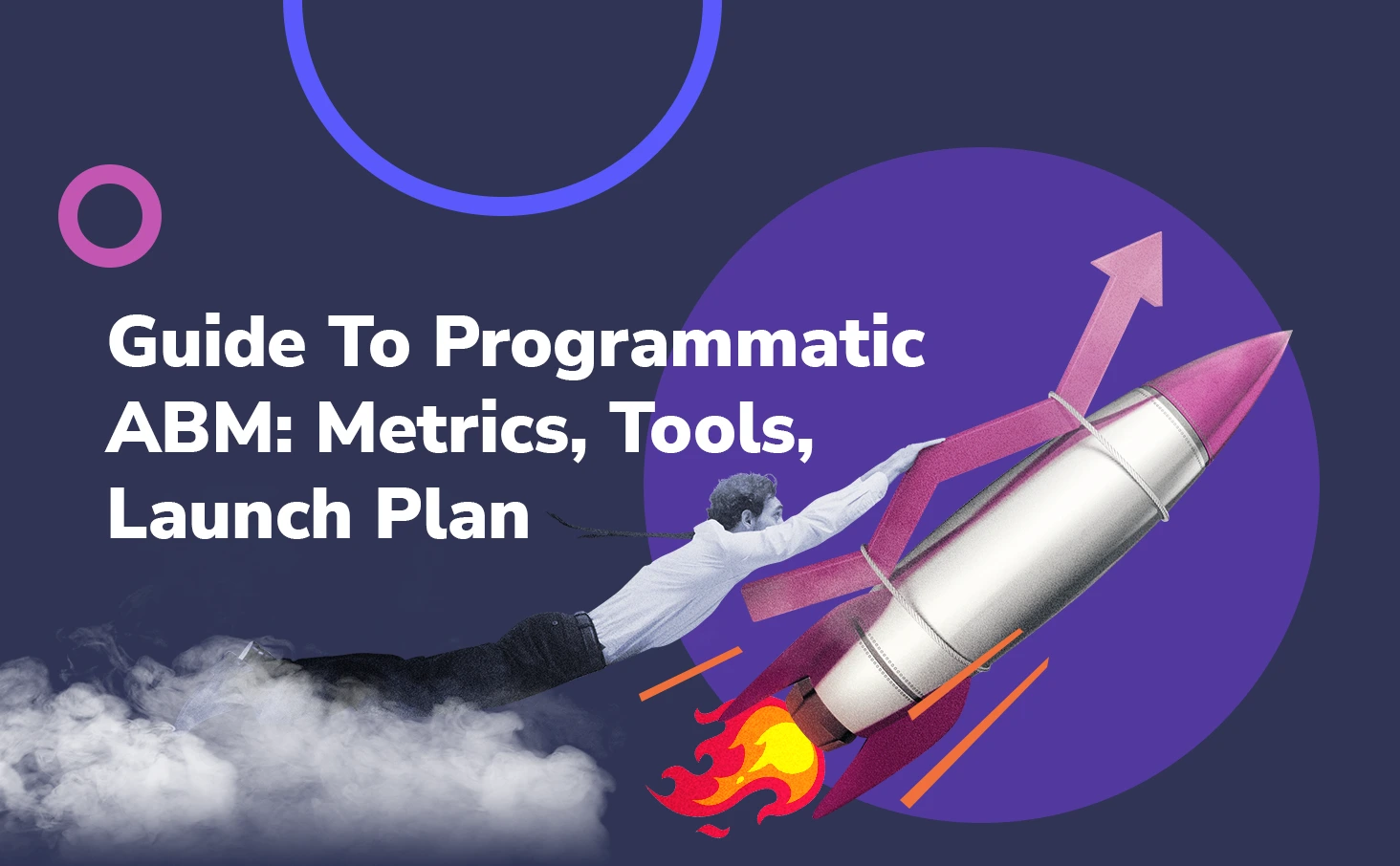
Yulia Olennikova
~11 min
Guide To Programmatic (One-To-Many) ABM: Metrics, Tools, Launch Plan
Are you on a mission to drive more revenue for your business? Are you tired of traditional marketing strategies falling short?
Well, you’re in luck! Programmatic ABM may be the solution to your marketing woes.
Programmatic ABM, also known as 1:Many ABM, is a type of account-based marketing that uses technology to scale the reach and personalization to target a larger number of accounts.
As opposed to the other 2 types of ABM (1:1 and 1:few), programmatic ABM requires less personalization but allows for a wider reach when it comes to the accounts you target. 1:1 ABM is incredibly personalized and it focuses on one-on-one relationships with specific accounts, while 1:few ABM is highly personalized and targets a few accounts.
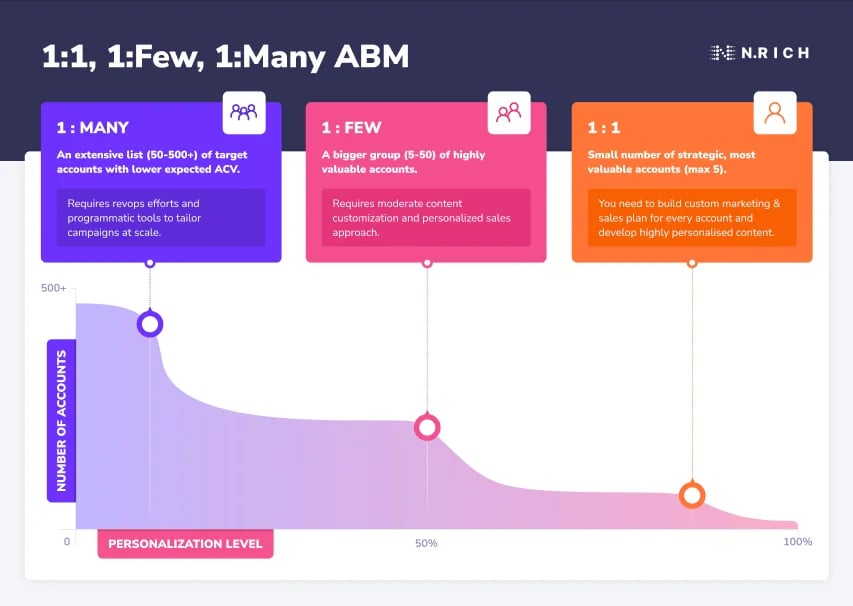
Out of the three, programmatic ABM offers the most cost-effective option for businesses and it's great for scaling B2B marketing campaigns.
However, like anything worth doing, programmatic ABM isn't without its challenges. ABM takes time to implement and yield results, so it's important to get the strategy right from the very beginning.
Also, the budget can be a concern as you'll need to invest in tools for programmatic ABM that aren't necessarily cheap. Speaking of tools, you'll need to make sure to choose the right ones if you want to ensure success as traditional advertising channels like Google and Facebook don't have the necessary capabilities you'll need to run ABM campaigns.
Furthermore, measuring the effectiveness of ABM campaigns can be quite tricky as ABM campaigns are usually multi-channel and involve many different touchpoints, so you'll need to ensure you're using the right metrics and tools in order to measure success and see what's working and what needs improvement.
But, don't let these challenges scare you off, we only mentioned them so that you can be aware of what's needed for ABM success and what to expect.
To save you the trouble of having to figure out the strategy, budget, and tools yourself, we've put together this guide which will walk you through all the steps of a successful programmatic ABM, from setting up the right metrics and choosing the right ABM tools to launch your ABM campaigns.
When You Need Programmatic ABM
Before we get into the exact steps you need to take, let's first talk about if you need ABM in the first place. This is extremely important as you don't want to invest time, money, and resources into a strategy that it's doomed to fail because it wasn't the best fit from the start.
So, when do you need ABM?
Well, whether you’re familiar with ABM or just about to launch your first campaign, it all comes down to two essential use cases:
1. You want to optimize costs - reduce CPC, CPL, and ultimately CAC.
Programmatic ABM can help you cut costs drastically by delivering your ads to a pre-determined list of your target accounts. This not only decreases wasteful spending on irrelevant ads but also gives you the ability to target better, which will in turn help you improve your campaigns’ performance and reduce mentioned metrics. Win-win!
2. You want to increase revenue - boost conversions, leads, and brand awareness
Programmatic ABM can help you achieve this goal in a very short time.
With ABM you get more personalized ads, the ability to target accounts that fit your buyer personas, as well as the ability to scale quickly with less effort. All of this has a direct effect on conversions, leads, and brand awareness.
Now you might be thinking "Well, don't all companies need ABM then?".
The answer is probably yes.
However, some companies might find other types of ABM or other strategies more beneficial, depending on the goals they want to achieve, the industry they're in, and so on. This is why you should always do your homework and make sure the programmatic ABM is the right choice before investing in it.
What we feel it's important to point out here is that if you're thinking about or you’re about to implement ABM strategies, but you see ABM as a hyper-targeted method that is worth using only with high-value prospects, that's not necessarily true.
1:1 (Strategic) ABM and 1:Few ABM (ABM Lite) are for those high-value accounts as they are highly personalized and require more effort. Whereas programmatic ABM is more for targeting a larger number of accounts that might not necessarily be high-value. The main goal here is to get in front in front of those accounts with your ads and build brand awareness, acquire new leads and convert them.
The best way to put it is: Programmatic ABM is a perfect solution when your target account list is too large to create individualized ABM strategies, but you still want to ensure your message is received and viewed by the key decision-makers within those companies.
Alright, now that we've established when ABM is needed, let's talk about how to do it.
Step 1. Define Goals And Metrics
As with anything you plan to do, Programmatic ABM included, it's essential to know what you want to achieve and how you will measure success.
To start, make sure to define your ABM goals and objectives. That will help you create the right strategy, plan your budget, and pick the right ABM tools.
Here are 3 top goals Programmatic ABM is being used for:
1. Boosting awareness and engagement (for further retargeting)
Getting more people to become familiar with your brand and engaging is probably the most common ABM goal out there. And it's no surprise since driving leads and conversions start with creating brand awareness. If we don't make people familiar with our product or service, how can we expect them to buy it? They don't even know it exists!
What makes Programmatic ABM an excellent fit for brand awareness campaigns is its ability to reach a big number of the right people. As opposed to running campaigns on, let's say LinkedIn, which is way more expensive and there's a chance some important decision-makers won't even be active on the platform, Programmatic ABM allows you to advertise across thousands of websites, so your ads will be seen by the right people.
Also, most ABM advertising tools integrate with other platforms, like Google, LinkedIn, or Facebook allowing for further retargeting and lowering CPC and CPL (those are the key metrics you’ll look after, more on that later).
2. New deals
This one is pretty self-explanatory. Programmatic ABM allows you to reach more people that fit exactly the profile of your ideal buyer persona, so you can reach a bigger number of ideal prospects while, at the same time, providing them with a more personalized experience. When you look at it like that, it's easy to see why Programmatic ABM is used and it's doing great in terms of acquisition.
3. Upsells
If you have hundreds or thousands of customers, and the majority of them are using the basic version of the program while there's an option to upgrade, you basically have the gold mine right there. Selling to an existing customer is easier than attracting a new one, so using Programmatic ABM to do so on a scale is an excellent way to increase revenue.
Now, based on the goals you set, you'll pick the appropriate metrics that will indicate if you're on the right track.
For brand awareness, the key ABM metrics are:
- Impressions
- Click-through rate
- Visitors
- Website activity increase
When it comes to acquisition goals, ABM metrics you'll want to look at are cost per lead (CPL), the number of leads you get, conversion rate, and cost per acquisition (CPA).
And for upsells, the metrics to pay attention to are ROI and revenue increase.
As we said, these metrics depend on the ABM goal, and based on the goal you set, you'll pick the metrics that will indicate success. There are a couple of metrics that are of huge importance and that should be monitored with every ABM campaign, but more on that later.
Once you have defined your goals and picked the metrics, you're ready for the next step.
Step 2. Build Target Account Lists
The biggest difference between ABM and other marketing strategies, like classic lead generation, is that ABM puts a lot of emphasis on personalization and it's all about knowing the problems and pain points of the right people, how to target them for maximum results, and the right message that will make them take action.
So, to make sure you target the right people, you'll have to create target account lists with individuals and companies that meet certain criteria.
The list can consist of your existing customers (if you’re running an upsell campaign) or the accounts that aren’t buying from you yet (if you’re running an acquisition campaign). In most cases, it's usually a mix of both.
When it comes to the optimal target account list size, it depends on the budget you have and the goals, but it usually should be somewhere between 500 and 3000 accounts.
The steps for creating target lists are:
Defining your TAM
The Total Addressable Market, or Total Available Market, is the potential revenue that can be generated if a company were to capture 100% of the market share within a specific market.
To put it simply, it's the total amount of revenue that you could potentially generate if you were to sell to the entire market.
Knowing your ICP
The Ideal Customer Profile (ICP) is a detailed description of the perfect customer you want to target. This includes demographics, job titles, revenue size of the company, geographic location, and other characteristics. It's paramount to make sure the accounts that you target match the ICP for your ABM campaign to be successful.
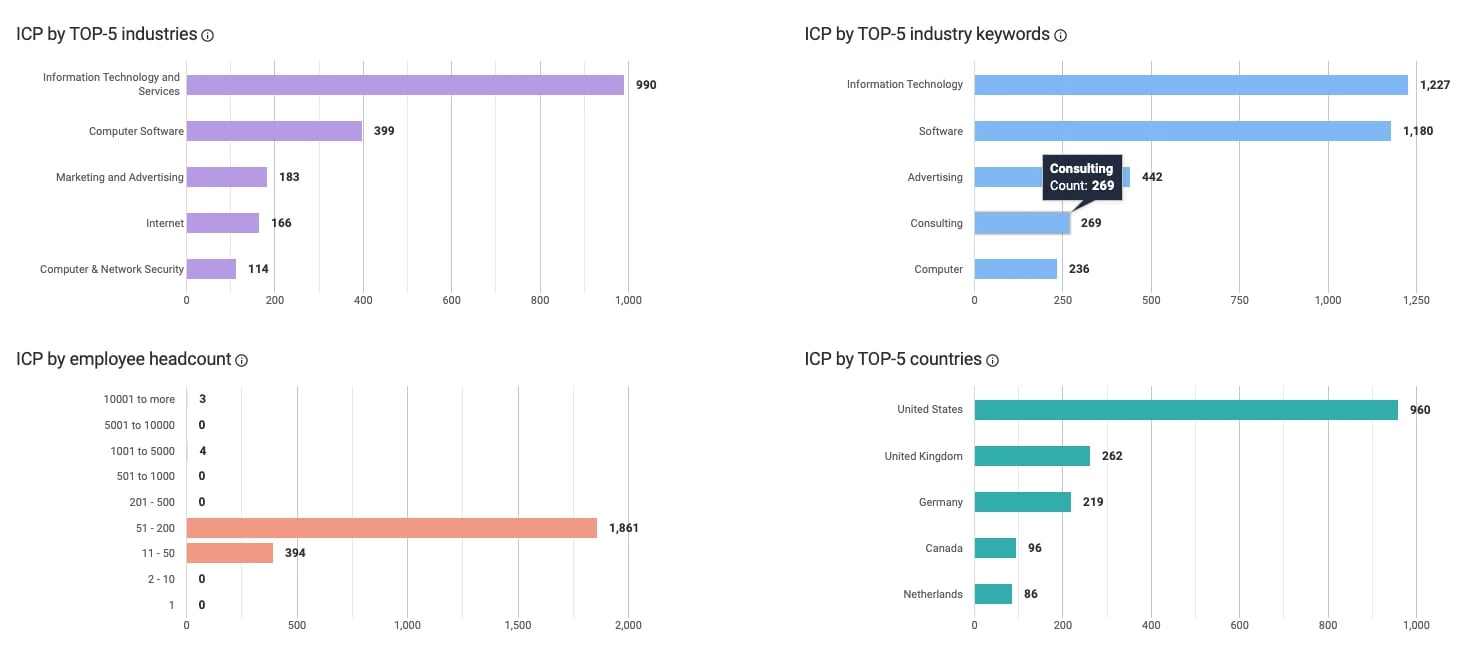
Source: N.Rich ICP Builder
Scoring accounts around sales velocity
Once you have the TAM and ICP, you'll want to score accounts based on the sales velocity.
Sales velocity is the speed at which prospects move through the funnel, from initial contact all the way to purchase.
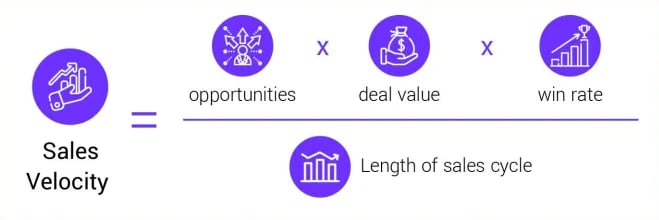
Scoring accounts will help you a bunch as this score will help you know which accounts have higher chances of buying from you and which don’t, which ones you should spend more time on, which could bring more revenue, and so on.
Now that you've target account lists, you're ready for the next step.
Step 3. Develop Creatives
Developing creatives is the fun part of ABM. It's where you get to create content that will engage your target audience, capture their attention, and make them take action.
Creatives include:
- Ads (social media, display, search)
- Content (blog posts, white papers, emails, etc.)
- Event Invitations
- Video and audio content
- Webinars and demos
The most important part when developing creatives for ABM is personalization. And although Programmatic ABM isn't as personalized as 1:1 ABM and 1:Few ABM, and isn't about personalizing everything for every single account, it still requires personalization to achieve the best results.
So what you want to do here is personalize the creatives based on the target accounts you've identified, and make sure they focus on the common problems of these accounts.
Here are a few more tips to keep in mind when creating creatives for an ABM programmatic campaign:
Repurpose existing content
When you are doing 1:Many ABM, repurposing existing content is a must. As we already said, personalization is key here, but you don't want to spend too much time and resources on creating content from scratch.
So, look for existing content that you already have and try to make as much as you can out of it. Repurposing is amazing for ABM campaigns, as it can save you tons of time and money and still provide great results.
Personalize by geo and niche
It's crucial to think about personalization and segmentation (by vertical, by geo, by use case) to make your creatives more relevant and attractive.
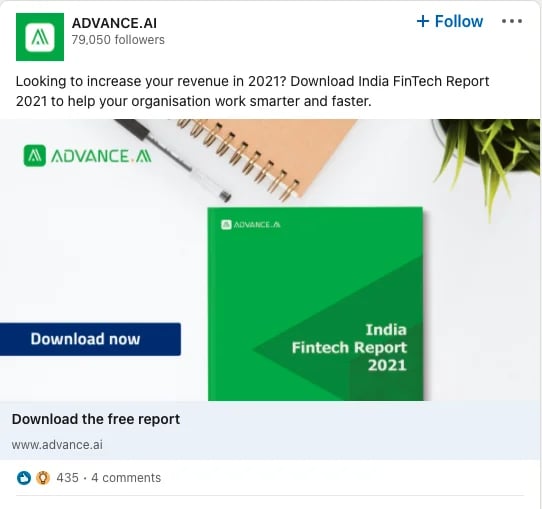
Source: advance.ai
The more relevant and personalized your creatives are, the better. So, what you want to do is segment your audience by vertical, geography, and use case and then create creatives based on those segments.
This will allow you to create more targeted and tailored creatives that will get better responses.
Stick to best practices
Another key to success with ABM programmatic is sticking to best practices. This includes:
- Use catchy design
- Use the right words
- Stay on top of trends
- Choose ad format carefully
- Differentiate ad creatives for customer segments
- Test, then launch
By following these best practices, you'll be able to create successful and effective creatives for your ABM programmatic campaigns. To learn more about each of these creatives best practices, check out this article: A Guide to Creative Best Practices For Awesome Ads.
Step 4. Think Through The Buyer Journey
Just launching an air cover campaign and calling it a day isn’t going to yield the maximum result.
Far from it.
What will, however, is thinking through the entire buyer journey — from first contact to conversion and beyond, and making sure you have proper integrations in place and the necessary content assets to do the following:
Build email nurture streams
Having an email capture form is great, but you also need an entire nurture stream in place to convert leads into customers in case you’re using email capture forms. You need to have an onboarding email series and a nurture flow set up with targeted emails that will lead your leads down the funnel.
Launch retargeting campaigns on other platforms (e.g. LinkedIn lead gen ads)
Retargeting campaigns are a fantastic way to remind your leads about you and your product/service and launching them on different platforms like LinkedIn or Facebook could be highly effective as it can prompt leads to take action and finally purchase from you.
Provide sales reps with the right content
Your sales team needs to have access to the right kind of content that they can use when speaking with potential customers. This includes case studies, battle cards, white papers, explainers, presentations, proposals, and other sales enablement content that will help sales reps close deals faster and easier.
These are the things many companies overlook when creating ABM programmatic campaigns and it's costing them direly. Don't be one of them! Take the time to really think through the buyer journey and make sure you have all the necessary ingredients in place to maximize success.
Step 5. Measure And Iterate
Once you did all the previous steps and finally launched your campaign, it's time to measure, analyze and optimize your campaigns to make sure you are getting the best results possible.
Doing so will help you understand what works best and what doesn't and allow you to make necessary changes to improve performance.
Measurement is always key when it comes to marketing success and ABM programmatic is no exception. Keep a close eye on your campaigns, measure them regularly and make sure to iterate and optimize them continuously.
Aside from the goals that you’ve set and key metrics that you defined, you'll also want to make sure to regularly check your programmatic ABM campaigns’ health. You do so by tracking intermediary metrics like:
- Engagement rate (how many accounts from the list are actually interacting with your campaigns?)
- Cost-per-click (CPC) or CPE (tools like N.Rich are using a more advanced CPE, cost-per-engagement model, that allows taking into account also engaged video views and the native article reads).
- Buyer intent: how actively your target accounts are engaging with your website and ads (first-party intent) or demonstrate interest towards your competitors and relevant keywords (third-party intent).
If you use a dedicated Programmatic ABM tool, you'll get a helicopter view of all the touchpoint that drove to conversion at every stage of the buyer journey.
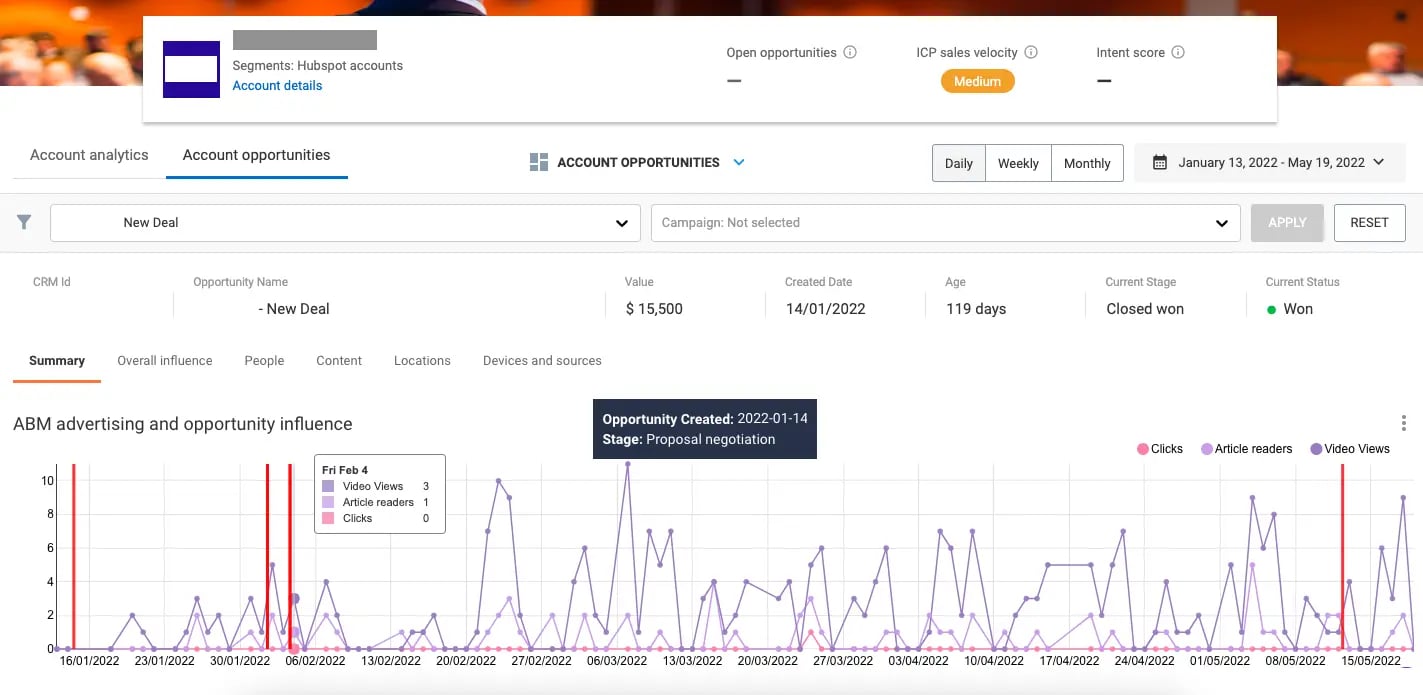
Source: N.Rich opportunity attribution report
By keeping a close eye on these metrics, you'll be able to continuously optimize your campaigns and always get the most out of them.
Before we can call it a wrap, let's take a look at how to choose the right programmatic ABM tool, as it will be the cornerstone of your ABM strategy.
How To Choose The Right Programmatic ABM Tool
The right Programmatic ABM tool is a fundamental factor for success. It can help you to plan and optimize your campaigns, set up multiple creative assets for different segments of the target audience, manage bids and budgets, and many other things.
When it comes to choosing the right platform, here are three aspects to take a look at before you make a decision:
1. Price
Ahh, it's always about the money. When choosing the right ABM Platform, make sure to inspect it from a financial standpoint and find out if it fits your budget. What you want to factor in here is the commitment period you plan to sign up for, as it makes a huge difference if you plan to commit to 6 months or 2 years.
2. Functionality
Once you know the price, it's time to analyze the actual features and functionalities of your ABM Platform. Make sure that whatever solution you're considering offers all the features you need to plan and execute high-performance ABM campaigns. These includes:
- Targeting capabilities
- Creative asset management
- Automation & Optimization
- Integrations with ad platforms and CRMs
- Reporting and analytics
3. Ease of use and support
Finally, you'll want to make sure the ABM platform you choose is easy to use and that it comes with great customer support.
ABM can be quite complex and you should look for a platform that will make it easier by providing lots of guidance and support. You don't want to spend time on tech issues or fighting with the ABM platform.
To check this, you can look at user reviews on G2 and similar platforms to see how quick the CS team is and how easy it is to get the tool up and running.
Need help with finding the perfect ABM tool to use?
Check out our guide to ABM advertising tools we wrote to get an overview of the best providers in the market and decide on the best fit for you.
Alright, it looks like we're all set here. Now it's your turn to launch your ABM programmatic campaigns and make a splash! So what are you waiting for? Go get 'em!
Yulia Olennikova
Marketing Manager at N.Rich